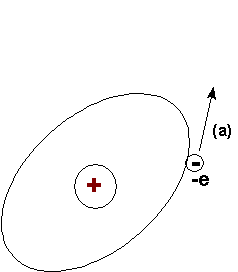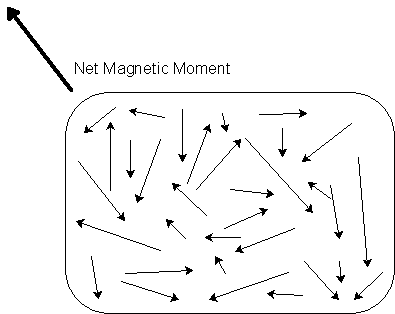| << Chapter < Page | Chapter >> Page > |
The magnetic moment of a material is the incomplete cancellation of the atomic magnetic moments in that material. Electron spin and orbital motion both have magnetic moments associated with them ( [link] ), but in most atoms the electronic moments are oriented usually randomly so that overall in the material they cancel each other out ( [link] ), this is called diamagnetism.


If the cancellation of the moments is incomplete then the atom has a net magnetic moment. There are many subclasses of magnetic ordering such as para-, superpara-, ferro-, antiferro- or ferrimagnetisim which can be displayed in a material and which usually depends, upon the strength and type of magnetic interactions and external parameters such as temperature and crystal structure atomic content and the magnetic environment which a material is placed in.
![]()
The magnetic moments of atoms, molecules or formula units are often quoted in terms of the Bohr magneton, which is equal to the magnetic moment due to electron spin
The magnetisim of a material, the extent that which a material is magnetic, is not a static quantity, but varies compared to the environment that a material is placed in. It is similar to the temperature of a material. For example if a material is placed in an oven it will heat up to a temperature similar to that of the ovens. However the speed of heating of that material, and also that of cooling are determined by the atomic structure of the material. The magnetization of a material is similar. When a material is placed in a magnetic field it maybe become magnetized to an extent and retain that magnetization after it is removed from the field. The extent of magnetization, and type of magnetization and the length of time that a material remains magnetized, depends again on the atomic makeup of the material.
Measuring a materials magnetisim can be done on a micro or macro scale. Magnetisim is measured over two parameters direction and strength. Thus magnetization has a vector quantity. The simplest form of a magnetometer is a compass. It measures the direction of a magnetic field. However more sophisticated instruments have been developed which give a greater insight into a materials magnetisim.
So what exactly are you reading when you observe the output from a magnetometer?
The magnetisim of a sample is called the magnetic moment of that sample and will be called that from now on. The single value of magnetic moment for the sample, is a combination of the magnetic moments on the atoms within the sample ( [link] ), it is also the type and level of magnetic ordering and the physical dimensions of the sample itself.

The "intensity of magnetization", M , is a measure of the magnetization of a body. It is defined as the magnetic moment per unit volume or
M = m / V
with units of Am (emucm 3 in cgs notation).

Notification Switch
Would you like to follow the 'Nanomaterials and nanotechnology' conversation and receive update notifications?